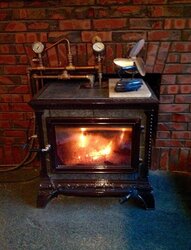I am starting a new thread. I will try to explain what I did to install the hot water system in my stove. I will start by saying, I have a good knowledge of construction, plumbing, electrical, contracting. I am not a beginner when it comes to making things. If you are not comfortable with what you are thinking of doing, please step back and stop or regroup. Wood stoves can be dangerous, so can water heaters.
I have heated my home with a wood stove since I moved in in 1986. I always wanted to integrate the water heat into it and finally did in 2013. In the winter I run my stove constantly, it is able to heat most of the hot water used in my home.
The stove is a Hearthstone Heritage. It is installed into the opening of the original fireplace. The home was built in 1932. I debated what and how to install the coil for a long time. I was originally going to drill into the soapstone to run the coil in, but felt I was committing some sort of soapstone stove sin. I settled on machining a new block off plate for the top of the stove that I drilled to run the tubing through. The coil is 3/4" stainless tubing. It goes into the top, loops in a rectangle above the internal heat deflector and exits through the top plate. I had the tubing bent by a friend who works at a local tubing shop. It has been a while but memory says the tubing was about .080" thick, this was not thin walled tubing. The interesting side to the coil bending part of the story was the guy is Russian. When he was a young boy his father installed water coils in wood stoves to make extra money. In the area they lived many people did not have water heaters, unless they added coils into their wood stoves.
I knew that the piping would be very visible. I opted to go for a Steampunk look, adding extra gauges and dials. There is a check valve 6" away from the entry point to the stove. Directly at the exit point there is a thermostat. It is fun to watch it as the water cycles. Next, 6" away is the thermo-switch to the solar controller. The system works almost identically to a roof solar panel. If you are familiar with them just envision the part in the stove as the part on the roof of a solar install. I installed the thermosensor a little away from the stove to help lengthen the runtime of the pump cycle. Next is a water per assure gauge. Not necessary, but looks cool. It usually is at about 64lbs, I am on a city water system, nog a well. There is an air blend valve by the pressure gauge but it was not really necerry, water velocity purges the air well.
I will jump to another post to describe the rest of the tank side of the system. I am afraid of loosing what I have already typed.
I have heated my home with a wood stove since I moved in in 1986. I always wanted to integrate the water heat into it and finally did in 2013. In the winter I run my stove constantly, it is able to heat most of the hot water used in my home.
The stove is a Hearthstone Heritage. It is installed into the opening of the original fireplace. The home was built in 1932. I debated what and how to install the coil for a long time. I was originally going to drill into the soapstone to run the coil in, but felt I was committing some sort of soapstone stove sin. I settled on machining a new block off plate for the top of the stove that I drilled to run the tubing through. The coil is 3/4" stainless tubing. It goes into the top, loops in a rectangle above the internal heat deflector and exits through the top plate. I had the tubing bent by a friend who works at a local tubing shop. It has been a while but memory says the tubing was about .080" thick, this was not thin walled tubing. The interesting side to the coil bending part of the story was the guy is Russian. When he was a young boy his father installed water coils in wood stoves to make extra money. In the area they lived many people did not have water heaters, unless they added coils into their wood stoves.
I knew that the piping would be very visible. I opted to go for a Steampunk look, adding extra gauges and dials. There is a check valve 6" away from the entry point to the stove. Directly at the exit point there is a thermostat. It is fun to watch it as the water cycles. Next, 6" away is the thermo-switch to the solar controller. The system works almost identically to a roof solar panel. If you are familiar with them just envision the part in the stove as the part on the roof of a solar install. I installed the thermosensor a little away from the stove to help lengthen the runtime of the pump cycle. Next is a water per assure gauge. Not necessary, but looks cool. It usually is at about 64lbs, I am on a city water system, nog a well. There is an air blend valve by the pressure gauge but it was not really necerry, water velocity purges the air well.
I will jump to another post to describe the rest of the tank side of the system. I am afraid of loosing what I have already typed.


